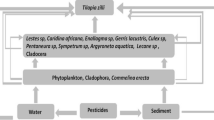Abstract
The dynamics of organochlorine pesticides (OCPs) and their major metabolites were studied in surface waters and plants of the River Xanaes (province of Córdoba, Argentina) during the annual dry season. The results of the 5-month monitoring study (April to August 2010) showed similar low contamination levels in nonagricultural mountain and agricultural areas in both water and plants. The concentrations of compounds detected in the surface water were <4.5 ng L−1, whereas concentrations of these substances in Myriophyllum aquaticum plants were <5 μg kg−1 (dry weight) with the exception of trans-permethrin (17.6 μg kg−1, dry weight). Because no notable differences in the contamination level between samples from the mountain and the agricultural area were observed, it was assumed that OCPs may not play an important role in today’s pesticide use in this area. Furthermore, the concentration–time trends for OCPs in the submerged plants showed a generally similar elimination behaviour independent of compound and sampling site, thus indicating an integral rather then a substance-specific process, such as partitioning between the plant and the ambient water. As known, rooted macrophytes can take up contaminants by way of roots, so sediments may be the principal source. To understand the dynamics of these compounds in the river area more deeply, thus further research should include study of the river sediment.


Similar content being viewed by others

References
Baudino OM, Suero EA, Augusto M, Gimenez ME, Flores N (2003) Monitoring organochlorine pesticides in surface and ground water in San Juan Argentina. J Chil Chem Soc 48:7–12. doi:10.4067/S0717-97072003000200001
Cataldo D, Colombo JC, Boltovskoy D, Bilos C, Landoni P (2001) Environmental toxicity assessment in the Paraná River delta (Argentina): simultaneous evaluation of selected pollutants and mortality rates of Corbicula fluminea (Bialvia) early juveniles. Environ Pollut 112:379–389
Cornelissen G, van Noort PCM, Parsons JR, Govers HAJ (1997) Temperature dependence of slow adsorption and desorption kinetics of organic compounds in sediments. Environ Sci Technol 31:454–460
Di Marzio WD, Sáenz ME, Alberdi JL, Fortunato N, Cappello V, Montivero C et al (2010) Environmental impact of insecticides applied on biotech soybean crops in relation to the distance from aquatic ecosystems. Environ Toxicol Chem 29:1907–1917
Doust JL, Schmidt M, Doust LV (1994) Biological assessment of aquatic pollution: a review, with emphasis on plants as biomonitors. Biol Rev 2:147–186
Enell A, Reichenberg F, Ewald G, Warfvinge P (2005) Desorption kinetics studies on PAH-contaminated soil under varying temperatures. Chemosphere 61:1529–1538
Gao J, Garrison AW, Hoehamer C, Mazur CS, Wolfe NL (2000) Uptake and phytotransformation of o,p′-DDT and p,p′-DDT by axenically cultivated aquatic plants. J Agric Food Chem 48:6121–6127
Gobas FAPC, McNeil EJ, Lovett-Doust L, Haffner GD (1991) Bioconcentration of chlorinated aromatic hydrocarbons in aquatic macrophytes. Environ Sci Technol 25:924–929
Grote M, Altenburger R, Brack W, Moschütz S, Mothes S, Michael C, Narten G-B et al (2005) Ecotoxicological profiling of transect River Elbe sediments. Acta Hydrochim Hydrobiol 33:555–569
Gupta PK, Gupta RC (1979) Pharmacology, toxicology and degradation of endosulfan. A review. Toxicology 13:115–130
Jergentz S, Pessacq P, Mugni H, Bonetto C, Schulz R (2004) Linking in situ bioassays and population dynamics of macroinvertebrates to assess agricultural contamination in steams of the Argentine Pampa. Ecotoxicol Environ Saf 59:133–141
Jergentz S, Mugni H, Bonetto C, Schulz R (2005) Assessment of insecticide contamination in runoff and stream water of small agricultural streams in the main soybean area of Argentina. Chemosphere 61:817–826
Knezovich JP, Harrison FL, Wilhelm RG (1987) The bioavailability of sediment-sorbed organic chemicals: a review. Water Air Soil Pollut 32:233–245
Marino D, Ronco A (2005) Cypermethrin and chlorpyrifos concentration levels in surface water bodies of the Pampa Ondulada, Argentina. Bull Environ Contam Toxicol 75:820–826
Miglioranza KSB, Aizpún de Moreno JEA, Moreno VJ, Osterrieth ML, Escalante AH (1999) Fate of organochlorine pesticides in soils and terrestrial biota of “Los Padres” pond watershed, Argentina. Environ Pollut 105:91–99
Miglioranza KSB, de Moreno JEA, Moreno VJ (2004) Organochlorine pesticides sequestered in the aquatic macrophytes Schoenoplectus californicus (C.A. Meyer) Soják from a shallow lake in Argentina. Water Res 38:1765–1772
Schulz R, Peall SKC, Dabrowski JM, Reinecke AJ (2001) Current-use insecticides, phosphates and suspended solids in the Lourens River, Western Cape, during the first rainfall event of the wet season. Water SA 27:65–70
Simonich SL, Hites RA (1995) Global distribution of persistent organochlorine compounds. Science 269:1851–1854
Turgut C, Fomin A (2002) The ability of Myriophyllum aquaticum (Vell.) Verdcourt in the uptake and the translocation of pesticides via roots with a view to using the plants in sediment toxicity testing. J Appl Bot 76:62–65
United Nations Environment Programme Report (2002) Programa de las Naciones Unidas para el Medio Ambiente. Evaluación regional sobre sustancias tóxicas persistentes. Sudamérica oriental y occidental. Informe Regional. Fondo para el medio Ambiente Mundial, Ginebra Suiza
Warren N, Allan IJ, Carter JE, House WA, Parker A (2003) Pesticides and other micro-organic contaminants in freshwater sedimentary environments—a review. Appl Geochem 18:159–194
Acknowledgments
We thank D. Silva and R. Gaydou for excellent technical assistance and especially D. Wunderlin and M. Ame for permission to use the laboratory infrastructure for sample preparation. We also thank E. Schymanski for reading the manuscript. This work was funded by the German Academic Exchange Service by way of a doctoral scholarship for R. Schreiber.
Author information
Authors and Affiliations
Corresponding author
Electronic supplementary material
Below is the link to the electronic supplementary material.
Rights and permissions
About this article
Cite this article
Schreiber, R., Harguinteguy, C.A. & Manetti, M.D. Dynamics of Organochlorine Contaminants in Surface Water and in Myriophyllum aquaticum Plants of the River Xanaes in Central Argentina During the Annual Dry Season. Arch Environ Contam Toxicol 65, 466–473 (2013). https://doi.org/10.1007/s00244-013-9929-x
Received:
Accepted:
Published:
Issue Date:
DOI: https://doi.org/10.1007/s00244-013-9929-x



